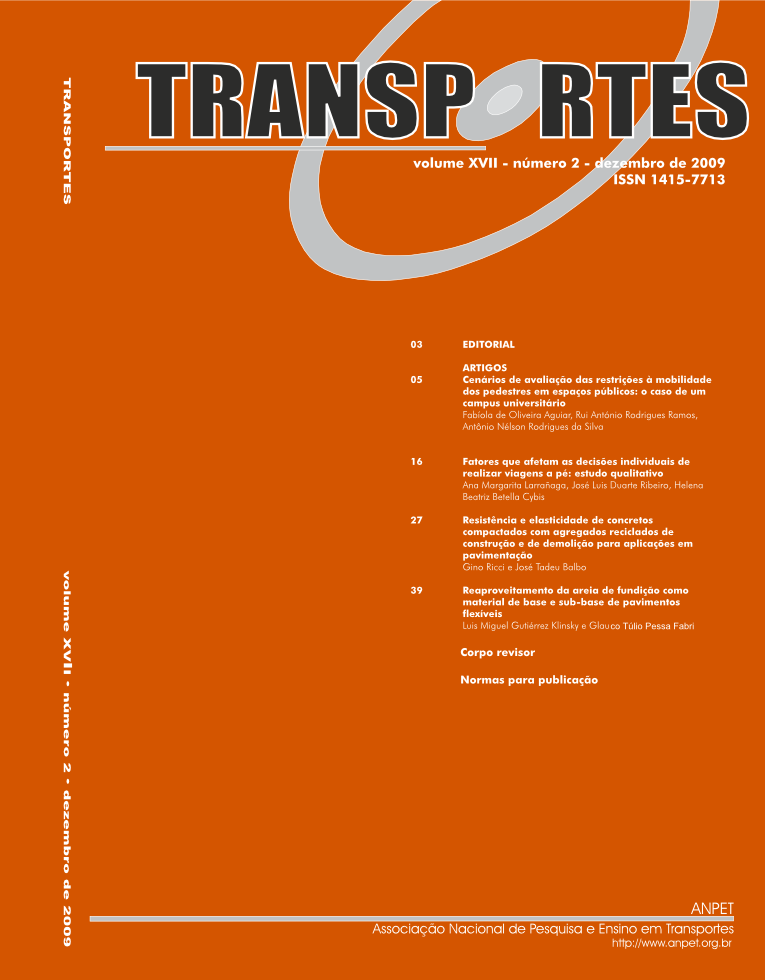Reaproveitamento da areia de fundição como material de base e sub-base de pavimentos flexíveis
DOI:
https://doi.org/10.14295/transportes.v17i2.358Abstract
O principal resíduo das indústrias de fundição é a areia de fundição de descarte que, no ano 2007, no Brasil, ultrapassou os três milhões de toneladas. Com o objetivo de preservar os recursos naturais e diminuir a degradação do meio ambiente, procuram-se alternativas para reutilizar a areia de fundição em grandes quantidades e a utilização na construção de rodovias fornece oportunidades. Assim, este trabalho avaliou a possibilidade de reutilizar a areia de fundição, misturada a solos argilosos, como material de base e subbase para rodovias de baixo volume de tráfego e vias urbanas para a região de Sertãozinho/SP, que é geradora de resíduo de areia de fundição, mas carece de jazidas de solos arenosos para a construção de rodovias. No estudo foi empregada a técnica de estabilização granulométrica para obter misturas solo-areia em diferentes proporções, nas quais foram realizados ensaios de classificação, propriedades mecânicas e ambientais. Os resultados dos ensaios mostraram que solos argilosos com 60% de areia de fundição adicionada poderiam ser utilizados como material de sub-base e base para pavimentos de tráfego leve, com baixo risco de poluir o meio ambiente.Abstract: The main residue of the foundry industries is the foundry sand that in 2007, in Brazil, exceeded three millions tons. The modern world searches the preservation of the natural resources and the reduction of the environment degeneration. Aiming at these objectives, new alternatives are researched to reuse the foundry sand in large amounts and the pavement construction provides opportunities. This paper evaluated the reuse of the foundry sand in pavement sub-bases and bases, through its incorporation to clay soils from Sertaozinho/SP. This region has a high production of foundry metals and residues, and does not have natural sandy soils deposits for pavement construction. This study used the mechanic stabilization technique to obtain soil-sand mixes and classification tests, mechanical properties tests and environment tests were done in these artificial soils. The results showed that clay soils with the addition of 60% of foundry sand could be used as sub-base and base material for low traffic pavements, with low risk of environment pollution.
Downloads
Download data is not yet available.
Downloads
Published
2009-07-02
How to Cite
Klinsky, L. M. G., & Fabbri, G. T. P. (2009). Reaproveitamento da areia de fundição como material de base e sub-base de pavimentos flexíveis. Transportes, 17(2). https://doi.org/10.14295/transportes.v17i2.358
Issue
Section
Articles
License
Authors who submit papers for publication by TRANSPORTES agree to the following terms:
- The authors retain the copyright and grant Transportes the right of first publication of the manuscript, without any financial charge, and waive any other remuneration for its publication by ANPET.
- Upon publication by Transportes, the manuscript is automatically licensed under the Creative Commons License CC BY 4.0 license. This license permits the work to be shared with proper attribution to the authors and its original publication in this journal, and to be adapted for non-commercial purposes, provided appropriate credit is given and any derivative works are distributed under the same terms.
- Authors are authorized to enter into additional separate contracts for the non-exclusive distribution of the version of the manuscript published in this journal (e.g., publishing in an institutional repository or as a book chapter), with recognition of the initial publication in this journal, provided that such a contract does not imply an endorsement of the content of the manuscript or the new medium by ANPET.
- Authors are permitted and encouraged to publish and distribute their work online (e.g., in institutional repositories or on their personal websites) after the editorial process is complete. As Transportes provides open access to all published issues, authors are encouraged to use links to the DOI of their article in these cases.
- Authors guarantee that they have obtained the necessary authorization from their employers for the transfer of rights under this agreement, if these employers hold any copyright over the manuscript. Additionally, authors assume all responsibility for any copyright infringements by these employers, releasing ANPET and Transportes from any responsibility in this regard.
- Authors assume full responsibility for the content of the manuscript, including the necessary and appropriate authorizations for the disclosure of collected data and obtained results, releasing ANPET and Transportes from any responsibility in this regard.









